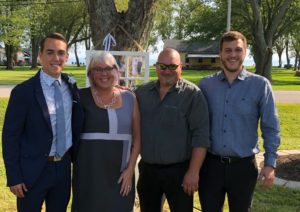 Brenda Ferri was diagnosed with fibromyalgia in 2012. She had finally won the fight for a conclusive diagnosis, but her fight with the neuroimmune disorder was just beginning.
Brenda Ferri was diagnosed with fibromyalgia in 2012. She had finally won the fight for a conclusive diagnosis, but her fight with the neuroimmune disorder was just beginning.
Ferri first noticed recurring pain in late 2010. Having a complicated medical history already (Ferri was diagnosed with Legg-Calve-Perthes Disease at fourteen and had a total hip replacement at thirty four), she brushed it off as the typical aches and pains of getting older for as long as she could. Eventually, though, it started to detract from her ability to function in daily life. Ferri recalls physically struggling to get out of bed, but when she started experiencing sharp pains while trying to shower, she knew she had to act.
Ferri’s first step was to make an appointment with her family doctor. However, her widespread and unidentifiable pain led to a less than satisfactory diagnosis. The doctor suggested, perhaps dismissively, that given her age and extenuating history of poor health, she was probably just getting arthritis or depression. She was prescribed a painkiller and sent home without being tested at all. Despite following her doctor’s instructions, the then-forty-four year old continued to experience widespread pain.
As a survivor of Legg-Calves-Perthes disease, Ferri was no stranger to pain. Commonly arising in children between the ages of four and eight, the disease involves the partial death of the hip joint, causing hip and leg pain and reduced mobility. She was sent to Sick Kids Hospital in Toronto as a young adolescent and had to endure two surgeries to prolong the life of her hip. Despite the illness complicating her childhood, Ferri was a spirited and athletic person in her youth, playing baseball well into her thirties. But life with her damaged hip grew too difficult when she became a wife and the mother of two young children, causing Ferri to finally have an artificial hip replacement surgery in 2000.
Many survivors of Legg-Calve-Perthes disease do suffer from arthritis later in life. Those diagnosed later in childhood, like Ferri, are at increased risk of future problems because the bone is more mature, and therefore less capable of healing than in younger children. These facts may explain why Ferri’s doctor was so quick to leap to a diagnosis of arthritis and depression (mood disorders are also common in those who have experienced life-changing surgeries). However, Ferri’s hip replacement was a total success, allowing her the mobility she needed to spend time with her children and the freedom to be herself. This new pain, ten years later, was something wholly different.
Convinced she had been misdiagnosed and still struggling with chronic pain, Ferri returned to the doctor the following year. She explained that the pain didn’t feel like the joint pain of her youth, or even muscle pain, but rather nerve pain. Her determination was successful, but fleetingly so: she was sent to do blood work, but when her results came back normal, she was again dismissed with nothing but a low-grade painkiller to show for it. At this point, Ferri had to seek a second opinion.
In early 2012, Ferri started seeing a rheumatologist. She was subjected to numerous tests to eliminate possible causes of her symptoms, but each just confirmed what the rheumatologist already knew: Ferri was a sufferer of fibromyalgia.
Finally, she had an answer. Her chronic pain wasn’t in her head; it wasn’t depression; and it had little or nothing to do with her surgical history.
But her journey was far from over. Fibromyalgia is a complex disease to diagnose, and even more difficult to treat. The disease is often miscategorized as an autoimmune disease, but it actually originates in the brain rather than the immune system. Though researchers believe the disease operates by amplifying pain signals that are sent to the brain, much remains to be learned about how and why people get it. There are some links between trauma survival and fibromyalgia diagnoses, but many of those diagnosed with the disorder cannot identify a specific trigger event. Women are also more vulnerable to fibromyalgia than men.
Based on this somewhat murky understanding of the science behind fibromyalgia—is it an autoimmune disease? A mental illness? A chronic pain disorder?—there’s no known cure, and treatment plans often have to target each symptom individually. The primary symptoms are chronic pain, fatigue, and a form of cognitive difficulty colloquially known as “fibro fog.”
Though her diagnosis did give her the information she needed to seek treatment, Ferri’s search for a medication that actually helped was a difficult one. Moving quickly from Cymbalta to Lyrica to Gabepantin, Ferri found that each of these drugs, regardless of whether they helped with the pain (or, as in some cases, barely made a dent), had side effects that were simply not worth it to her. Now a grandmother, Ferri was more determined than ever to keep her energy up and have a fulfilling life; this meant that the extreme lethargy and weight gain that Ferri experienced while on these drugs was a hindrance she wasn’t willing to tolerate.
Finally, after half a dozen failed medication regimens, Ferri discovered that Tramadol was the best drug for her quality of life. Tramadol is a synthetic opioid painkiller. Though the medication is most often used in post-operative patients, Ferri felt Tramadol produced fewer negative side effects while effectively managing her pain.
Though she was initially apprehensive about using painkillers in the long-term, Ferri has accepted that this is the best way for her to live the life she wants to lead in her fifties.
Now fifty-three, Ferri is an experienced “fibro-warrior.” Her daily routine involves lots of rest, knowing her limits, and relying on her family. She works with the St. Catharines branch of March of Dimes Canada, an organization which provides resources to Canadians with physical disabilities. Ferri’s job helps people with disabilities live independently, particularly those who could not manage without the charity’s support. Her experience with her own disability enriches her career and gives her the passion to keep going, though it can be hard working with fibromyalgia. Along with the Tramadol for the pain, Ferri keeps an extensive set of notes and to-do lists to cope with the forgetfulness of “fibro-fog.”
With nearly ten years since her diagnosis, Ferri is still going strong, but she believes in fighting for a better future, not just for other fibro-warriors but for everyone who has to navigate the Ontario health care system. One of Ferri’s most difficult battles now is advocating for her mother, recently diagnosed with dementia and placed in a nursing home. Ferri can see her own past struggles to be heard in the health care system reflected in her mother’s inability to communicate her needs and receive adequate care as a senior. Through Ferri’s battle with fibromyalgia and all the other health problems she’s experienced, either first or secondhand, this is the message she carries with her:
“My hope is that our health care system will become easier to manoeuvre through than it is now. My hope is that our seniors will be better taken care of than they are now. My hope is that our children will be better taken care of than they are now. My hope is that my kids and grandkids will have easy access to doctors and specialty doctors if they are sick… I guess I see the future as hope. For me I will wake up every day and continue to do what I do no matter how hard it is… One day at a time. I am a fibro warrior and will keep on fighting.”






